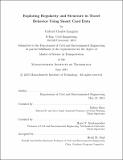Exploring regularity and structure in travel behavior using Smart Card data
Author(s)
Goulet-Langlois, Gabriel
DownloadFull printable version (3.853Mb)
Other Contributors
Massachusetts Institute of Technology. Department of Civil and Environmental Engineering.
Advisor
Jinhua Zhao and Haris N. Koutsopoulos.
Terms of use
Metadata
Show full item recordAbstract
As the economic opportunities fostered by large cities become more diverse, the travel patterns of public transport users become more heterogeneous. From personalized customer information, to improved travel demand models, understanding these heterogeneous travel patterns is useful for a number of applications relevant to public transport agencies. This thesis explores how smart card data can be used to analyze and compare the structure of individual travel patterns observed over several weeks. Specifically, the way in which multiple journeys and activities are ordered and combined into repeated patterns, both by the same individual over time and across individuals is evaluated from the journey sequence of each user. The research is structured around three objectives. First, we introduce a representation of individual travel patterns and develop a measure of travel sequence regularity. The mobility of each individual is modeled as a stochastic process with memory, of which each new realization represents an activity or journey. Entropy rate, a measure of randomness in the stochastic process, is used to quantify repetition in the order of journeys and activities. This analysis reveals that the order of events is an important component of regularity not explicitly captured in previous literature. Second, we develop an approach to identify clusters of travel patterns with similar structure considered with respect to public transport usage and activity patterns. Finally, we present an exploratory evaluation of the associations between the identified clusters and socio-demographic characteristics by linking smart card data to an annual travel diary survey. These three objectives are considered in the context of a practical application using the transactions of a sample of approximately 100,000 users collected between February 10th and March 10th 2015 in London.
Description
Thesis: S.M. in Transportation, Massachusetts Institute of Technology, Department of Civil and Environmental Engineering, 2015. This electronic version was submitted by the student author. The certified thesis is available in the Institute Archives and Special Collections. Cataloged from student-submitted PDF version of thesis. Includes bibliographical references (pages 161-166).
Date issued
2015Department
Massachusetts Institute of Technology. Department of Civil and Environmental EngineeringPublisher
Massachusetts Institute of Technology
Keywords
Civil and Environmental Engineering.